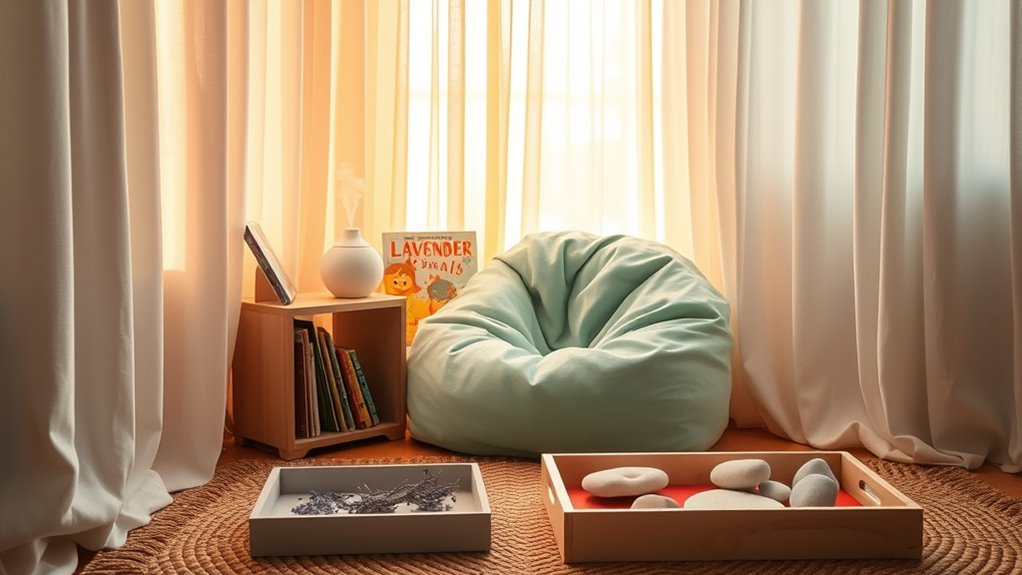To create a calming corner kids will actually use, make it cozy, private, and inviting by adding cushions, soft lighting, and sensory toys they enjoy. Involve your child in personalizing the space with their favorite blankets or stuffed animals to encourage ownership. Keep it tidy, update it regularly, and place it in a quiet area away from noise. Want tips on designing a space that kids feel safe and want to spend time in? Continue exploring for more ideas.
Key Takeaways
- Choose a quiet, private spot away from busy areas to make the space inviting and accessible.
- Include cozy seating, soft lighting, and calming scents to create a warm, soothing environment.
- Incorporate sensory toys and tools that are simple, engaging, and help children self-regulate.
- Involve the child in customizing the space with favorite items to foster ownership and regular use.
- Keep the area tidy, update it regularly, and maintain a calm, nurturing atmosphere to encourage frequent use.

Have you ever noticed how some kids need a quiet space to regroup and feel more centered? Creating a calming corner is a wonderful way to give them that refuge. The key is to design a space that feels inviting and safe, where your child can unwind whenever they need a break. To start, focus on making the area comfortable and accessible. Incorporate cozy seating, like soft cushions, small bean bags, or a plush armchair, so your child can settle in comfortably without feeling cramped or overwhelmed. The goal is to create a spot that beckons them to pause and relax, not something intimidating or clinical.
Creating a cozy, accessible space helps kids feel safe and relaxed when they need a break.
Adding sensory toys is essential in a calming corner. These toys engage your child’s senses in gentle, soothing ways, helping to reduce anxiety and promote self-regulation. Think about items like textured stress balls, fidget spinners, or squishy toys. Aromatherapy diffusers with calming scents can also enhance the sensory experience, making the space feel even more inviting. Keep in mind, the sensory toys should be varied but simple, avoiding overstimulation. The idea is to give your child tools they can use to calm themselves down when they’re feeling overwhelmed. Incorporating essential oils for calming like lavender or frankincense can further promote relaxation in the space.
Placement matters, too. Position the calming corner somewhere quiet and private, away from high-traffic areas where your child can truly feel like they have a retreat. If space allows, add soft lighting, such as a small lamp or fairy lights, to create a cozy atmosphere. Avoid harsh overhead lights that might make the space feel sterile or unwelcoming. The environment should feel warm and nurturing, encouraging your child to spend time there whenever they need a moment for themselves.
You should also involve your child in designing the space. Ask what makes them feel safe and comfortable. Maybe they want a favorite blanket, a small collection of books, or a particular stuffed animal nearby. Giving them some ownership over the calming corner boosts their sense of control and makes it more likely they’ll actually use it. Keep the area tidy and inviting, so it remains a place they want to visit. Regularly update the space with new sensory toys or cozy items to keep it fresh and engaging.
Frequently Asked Questions
How Do I Encourage Reluctant Children to Use the Calming Corner?
To encourage reluctant children to use the calming corner, you should use positive reinforcement whenever they try it, like praise or small rewards. Make the space inviting with sensory activities such as soft textures, calming lights, or gentle music. Let kids explore it at their own pace, and avoid forcing them. By consistently showing it’s a safe, helpful place, they’ll become more comfortable and willing to use it when needed.
What Are Budget-Friendly Ideas for Creating a Calming Space?
You can create a budget-friendly calming space by DIY decor, like painted jars or handmade banners, to add a personal touch. Incorporate sensory toys such as stress balls, textured fabrics, or scented items that soothe kids. Use inexpensive furniture like bean bags or cushions for comfy seating. Keep the area simple, organized, and inviting, encouraging kids to use it whenever they need a break or calming moment.
How Can I Personalize the Calming Corner for My Child’s Preferences?
To personalize the calming corner, incorporate your child’s favorite colors in decor and accessories, making the space inviting and familiar. Add sensory items that match their preferences, like soft blankets, textured toys, or calming lights. Let your child choose some decorations or comfort objects to guarantee the space feels truly theirs. This personalization encourages them to use the corner when they need a peaceful retreat.
What Safety Precautions Should I Consider When Designing the Space?
You should prioritize childproofing measures by securing furniture to walls and covering outlets. Use safety equipment like corner protectors and soft padding on sharp edges to prevent injuries. make certain the space is free of choking hazards, small objects, or anything toxic. Regularly check for damaged items, and supervise your child while they’re in the calming corner. These precautions create a safe, inviting space where your child can relax without risk.
How Do I Maintain the Calming Corner Over Time?
Ever wonder how to keep your calming corner inviting? You should regularly refresh decorative elements and rotate sensory tools to sustain interest. Keep the space clean and organized, and involve kids in choosing new items to foster ownership. By doing so, you guarantee the space remains a soothing retreat that kids genuinely want to use, supporting their emotional well-being over time. Regular updates make the calming corner a lasting resource.
Conclusion
By creating a calming corner, you give your child a safe space to unwind and regulate their emotions. With thoughtful elements and a cozy setup, you’re helping them build resilience and self-awareness. Isn’t it worth investing a little time to foster their well-being? When your child has a go-to spot to find peace, you’ll both enjoy a calmer, more balanced daily life. So, why not start today and watch their confidence grow?










